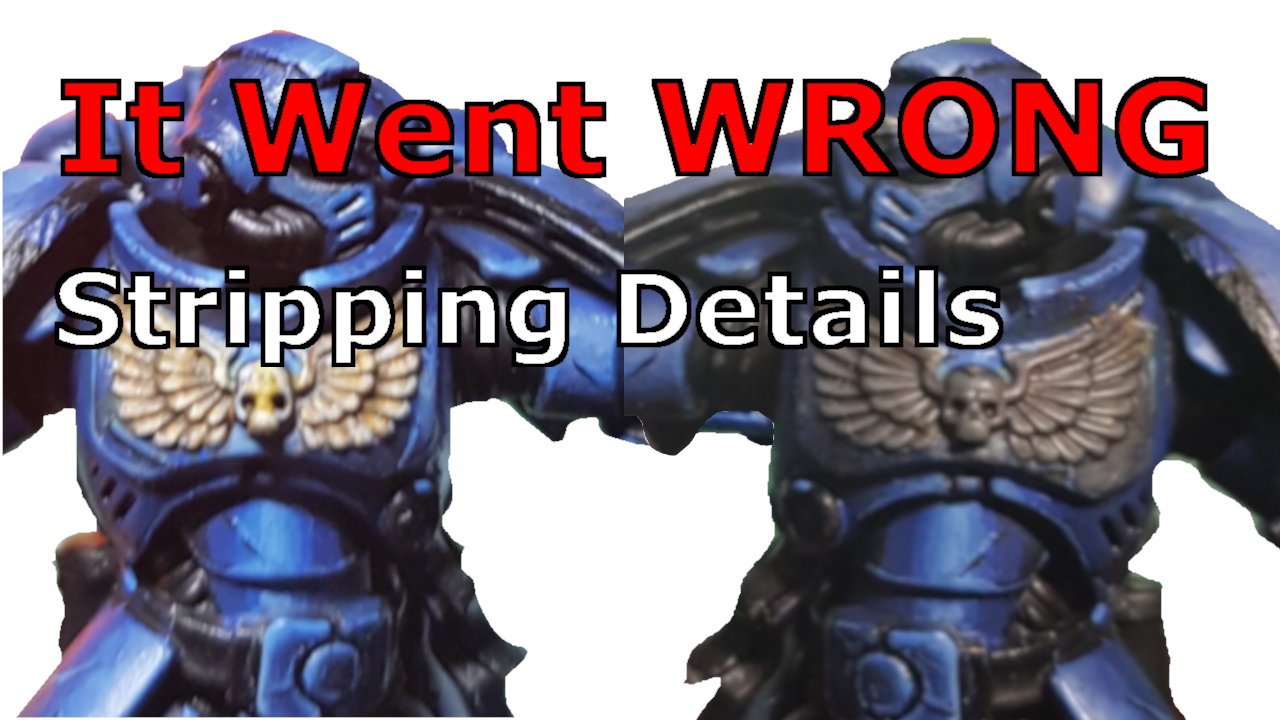Everything is going well, you’re proud of your work, it’s the best blending you’ve done in months. The freehand is exquisite, the edge highlighting is thin and crisp. It’s the perfect model, all you have left to do is the gold eagle in the center, but you want it to be nice, you want it blended too, you want perfect layers. You try, you try your best, and it looks awful. The centerpiece of your model is now textured and blurred and everything in the world is ruined. Unless you can strip a single part of the model and start again. But how?
All miniature painters have experienced the moment you mess up a single bit of a model, many of us resorting to stripping the entire thing in a bout of angry depression, perhaps to never repaint it again. Stripping individual parts of Warhammer and other miniatures is something I only recently discovered how to do, but it’s made fixing mistakes easier than I could ever imagine.

Disclaimer: An individual part with many gaps/edges is going to be very difficult to isolate and strip on it’s own. You can, but you’re going to find it difficult not to hit whatever is below! Usually, this can just be repainted however. Much better than redoing the whole model. In the case of the model I’m showing this on, I’m likely going to end up stripping the blue armour between the wings of gold.
We’re not going to be able to soak this miniature. Unless you can somehow figure out a way to soak the isolated area without getting chemicals everywhere. I however, haven’t figured out how to… yet. This means we need something that we can simply rub on, and it’s going to strip the paint easily and quickly, without needing to be left for hours. The only product I know of that can do this is Biostrip 20. This beast of a stripper removes paint simply by being rubbed on. It’s fine for plastic miniatures, and can be left on for hours without issues.

However do not leave this on resin or other similar materials or it WILL render them soft and unusable. If applied and rubbed off quickly I suspect it would work just fine, but I have yet to try this so attempt at your own risk.
If you don’t have access to Biostrip 20 or would prefer to use something different, you could perhaps apply isopropyl alcohol in small layers, so you’re able to achieve the paint removal without soaking the miniature. It may be easier if using a liquid to remove the whole part and soak it completely, but I will check this out and inform on the best way later!
If you’re stripping a fairly large area and you’re able to, use masking tape! This will make certain you don’t hit the areas you don’t want to. However, for stripping individual miniature parts with curved surfaces and embossed/dipped details, we’re going to have to simply be careful.

With miniatures where you can use masking tape, all we need to do is dollop on our Biostrip 20, wait, and scrub off when ready. It really doesn’t take long, you can essentially begin scrubbing the instant you apply the Biostrip 20. I myself like to use a Q-tip/cotton bud to apply the paint stripper.
The paint here is extremely thick, but it doesn’t matter, some determined scrubbing and a rinse, and in about 4 minutes our model has the strip we wanted stripped. Strip. We can then peel back the masking tape to reveal the area we want to repaint, very useful if you mess up a certain effect or ambience you want to get perfect!
When it comes to stripping individual miniature parts, we use a Q-tip/cotton bud and rub carefully at the area we want to clean of paint, adding more Biostrip 20 as and if it’s needed. You do not need much, so use less than you think you’ll require.
Rubbing the Biostrip on, you’re able to simply bring the paint away in a matter of seconds, the issue arising from paint that you can’t reach in the recesses. If you find that you’re having trouble getting the paint out said recesses, simply leave the Biostrip to soak in for a while, and come back to scrub it off. Dabbing a paper towel, or using a toothbrush to reach hard spots, is also useful here if you find parts difficult. Make sure you rinse any excess Biostrip off when you’re finished, or it may bleed on to other parts of your miniature.

You can keep going if you want, removing more paint until it reaches the level of clean you desire, but I often don’t see the need – unless there’s some pretty bad texture still going on.

And that is the end of my guide into stripping individual miniature parts, I hope you found it useful, and feel free to comment if you have any tips or tried this out for yourself. I am always available to chat on Twitter, or our Discord.
If you would like to check out my YouTube Channel, Twitch, Twitter, or Commission a Model for Stripping and Painting, check out the links you just read!
To read more about the site: Go here
If you want to read more about us: Click here

